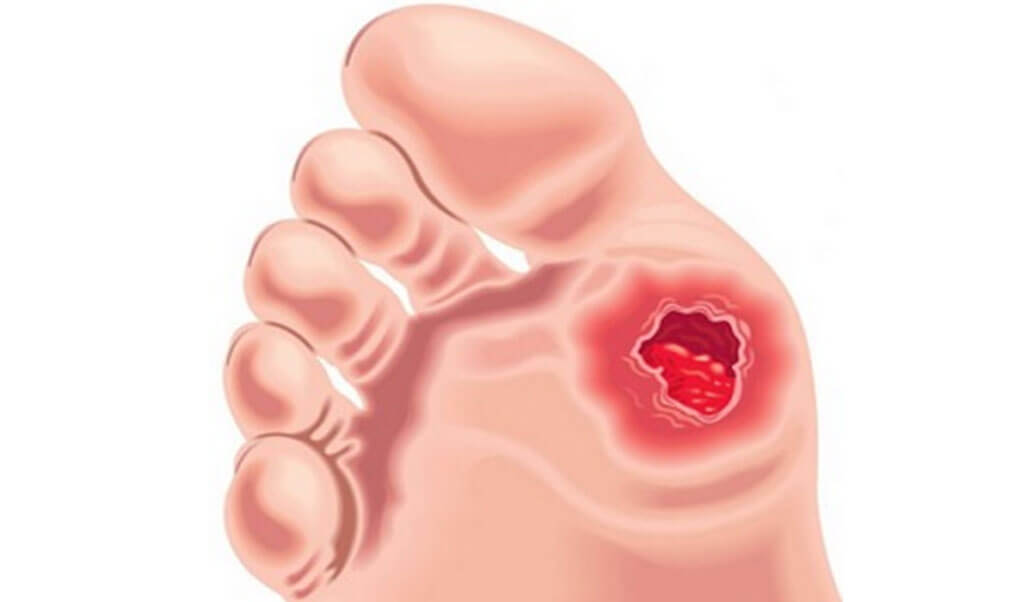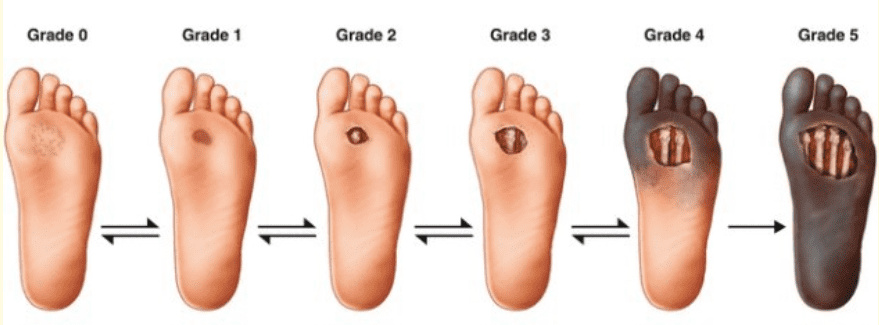Calls for Ukraine
Calls for Europe
Calls for USA

Diabetic foot is a rather dangerous complication of diabetes mellitus, in which the tissues of the foot are damaged and die. Another name for this condition is diabetic foot syndrome. The peculiarity of this complication is the destruction and death of small vessels, nerve endings, muscles, bone tissues of the legs. In the case of significant necrosis of the foot in diabetes, amputation is necessary.
According to statistics, this syndrome develops in 8-10% of people with diabetes mellitus, and in type 2 diabetes, the incidence of this pathology is an order of magnitude higher than in type 1 diabetes. Necrotic processes in the legs are one of the most common causes of death in diabetes. Therefore, at the first symptoms of pathological changes in the lower extremities, an urgent need to consult a doctor and begin treatment of a diabetic foot.
Violation of metabolic processes, namely glucose metabolism in tissues, is the main cause of diabetic foot syndrome. A high concentration of glucose causes damage to blood vessels and destruction of nerve endings. The blood supply to the extremities noticeably worsens, they begin to receive less oxygen, which leads to the gradual death of tissues.
There are several types of the disease:

Symptoms depend on the type of disease. The main signs of a diabetic foot in the event of a neuropathic form:
Symptoms of ischemic diabetic foot:
The mixed form develops with a longer development of diabetes and carries signs of different types of lesions.
The first signs of a diabetic foot are thickening of the skin. Then symptoms such as calluses appear, cracks appear on the skin, and sensitivity decreases. Later, redness, ulcers, and necrosis appear.

With a diabetic foot, the stages are determined by the degree of tissue damage:
This disease is said if diabetes is present and typical symptoms appear. For a more detailed diagnosis of the condition, a number of additional studies can be carried out:
Diagnosis also includes analysis of the contents of ulcers.
In the initial stages of the disease, conservative treatment is used. With its help, it is often possible to slow the progression of the disease. In the later stages, there is a need for surgery. Conservative treatment includes the use of drugs that improve blood circulation, medication, antibiotic therapy, normalization of sugar levels, treatment of the diabetic foot with antiseptic agents.
The doctor selects surgical methods taking into account the degree and characteristics of the damage. Removal of non-viable areas of skin and other tissues, angioplasty of the vessels of the legs with stenting, endarterectomy (removal of blood clots from the vessels of the legs and normalization of blood flow) can be carried out. In severe situations, amputation is required for diabetic foot.

Cell therapy is one of the most promising methods to effectively fight this disease. For this purpose, mesenchymal stem cells are used, the peculiarity of which is the possibility of transformation into any other cells of the body.
Studies have shown that the use of this technique has a positive effect in several areas:
There is evidence that angioplasty in combination with the introduction of stem cells can improve blood circulation in severe diabetic foot and have a beneficial effect on the healing of ulcers.
Mesenchymal stem cells are taken from the patient’s bone marrow or adipose tissue. After the cell sampling is carried out, their number is increased in the laboratory. Then the drug is administered to the patient directly into the affected area on the leg or intravenously. The doctor selects the dosage of the drug and the number of injections individually for each patient.
This is one of the most formidable complications caused by diabetes. After the onset of gangrene and amputation, the risk of death in the patient increases significantly. According to statistics, more than 50% of people after amputation die within 5 years. However, if you pay attention to the problem at the first symptoms, use effective methods of therapy, monitor the level of sugar, then the condition can be taken under control and live with this medical problem for a long time.
In order to choose the optimal treatment, you can seek help from the best clinics around the world. Contact us and the medical coordinators of MedTour will help you choose a clinic that can provide you with the best medical care, taking into account the characteristics of your condition.
If you are interested in cell therapy, we will advise you on treatment options in the best clinics that use stem cells to combat diabetes and its complications.
The endocrinologist and surgeon are engaged in the treatment of this pathology. You can get treatment for diabetic foot from the best world-class doctors who not only have high medical qualifications, but also have extensive practical experience in the fight against the disease. Medical coordinators of MedTour will help you get to the leading specialists in this field of medicine and choose a doctor according to your needs.
To learn more about the use of cell therapy, you can sign up for an online consultation with Dr. Andrey Kovalchuk, Associate Professor, Candidate of Medical Sciences, surgeon. He is engaged in regenerative cell therapy for various pathological conditions and has a successful experience in the application of this technique.
What can not be done with a diabetic foot?
With a diabetic foot, even small injuries can become a serious problem, so avoid any foot injury. Do not wear uncomfortable or tight shoes. Do not walk barefoot on grass or sand. If you have signs of infection such as redness, inflammation, swelling, pain, or purulent discharge from the wound, contact your doctor immediately.
How does a diabetic foot start to hurt?
At the initial stage, the diabetic foot can be manifested by discomfort and slight soreness. Patients may experience a burning or tingling sensation in the foot, as well as slight pain when walking. But the symptoms may be mild and not cause severe discomfort and pain. Therefore, people with diabetes should be careful and consult a doctor if there are any suspicious changes and sensations in the legs.
What is stem cell treatment for diabetic foot?
Stem cells can promote the regeneration of damaged tissues in the legs, the growth of new blood vessels, and improve blood circulation in damaged areas. This can help restore the normal supply of oxygen and nutrients to the leg tissue, which promotes healing and prevents ulcers from developing. The use of cell therapy can improve the condition of the foot and avoid amputation.
Please rate the work of MedTour
